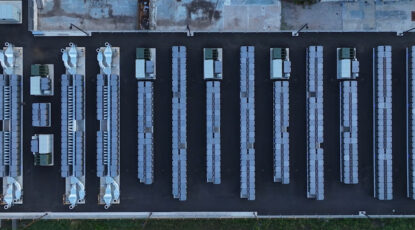What is a microgrid?
A microgrid, in short, is a localized energy system that can operate independently or in connection with the main electric grid. According to the U.S. Department of Energy (DOE), it is a controllable entity managing distributed energy resources (DERs) and loads with a defined boundary, capable of “islanding” during grid outages to keep local power on.
“Microgrids increasingly integrate renewables, storage, and fuel cells to support decarbonization and sustainability goals.”
How Microgrids Work
At its core, a microgrid is a small, local utility grid using DERs to supply critical loads. The goal of a microgrid is to control and monitor the sources so as to establish a stable frequency and voltage supply system for the local customer. When multiple sources are used microgrids employ a central controller, especially those that are connected with the main grid via a point of common coupling (PCC). Some of the DERs used in microgrids, which we’ll discuss in more detail below, include Solar photovoltaic (PV), wind, and renewable fuels.
When a microgrid operates alongside the main grid, its main goals could be one or a combination of the following:
a) reducing grid energy costs for the local load,
b) supporting the grid generation during peak demands,
c) providing frequency and voltage regulation services to alleviate problems coming from a weak utility,
d) improving the power availability for the customer.
For the latter, if a disturbance — which can include storms and wildfires along with short circuits or power outages — makes the main grid unstable or unavailable, the microgrid’s controller automatically isolates the system. It disconnects from the main grid and enters island mode to continue supplying energy from its own generation and storage assets.
Types of Microgrids
Based on the technology they are using, the installation scope and size of the loads Microgrids can be of two types: primary or secondary power sources. The primary power Microgrids aim to generate clean, uninterrupted power, while secondary power Microgrids are those that provide customers with partial power and reduce costs associated with the utility.
Primary power microgrids include:
- Grid-connected microgrids: Connect to the primary grid, drawing power from it or sending excess power back to it.
- Remote/off-grid microgrids: Operate independently from the primary power source, continuously operating in “island mode” and relying on local energy sources.
- Networked/nested microgrids: Involve two or more grids that are connected, sharing energy through a coordinated control system.
The majority of secondary power microgrids are the Renewable microgrids. These utilize a combination of renewable sources, such as solar, wind, and hydrogen fuel cells, that not only reduce the cost of energy, but also help achieve net-zero decarbonization goals.
While renewable sources like solar, wind or hydrogen could be included in the primary power microgrid category, their intermittent nature does not allow them to act independently to create a reliable source of continuous power for a customer. Such resources would have to be combined either with the utility, or a permanent source of power that is typically relying on natural gas to produce the minimum base power needed.
Renewable Microgrids
Renewable energy microgrids rely on DERs to generate and store electricity. These resources provide the microgrid with locally-sourced energy, allowing it to reduce utility costs and, when loads are low and battery costs are still economical, operate independently of the main grid.
Examples of Renewable DERs include the following:
- Solar: Converts sunlight into electricity using semiconductor cells.
- Wind turbines: Convert the kinetic energy of moving air into electricity via mechanical power
- Hydrogen or Biogas Fuel cells: Generate electricity through an electrochemical process, without emitting greenhouse gases.
- Batteries: Capture and store surplus electricity to utilize during periods of peak demand or outages.
Because wind and solar depend on the weather, while hydrogen fuel cells depend on a steady and cost effective supply of hydrogen, batteries are mandatory for such microgrids stability as they can store the excess energy, and provide power when the renewable generation is down. These applications may supply loads independent of the main grid if the solar/wind installations and installed battery capacity are oversized to match the load. They typically are grid connected and help lowering energy costs.
Renewables and clean technologies offer sustainable solutions by reducing carbon emissions, minimizing waste, and decreasing reliance on fossil fuels. This combination of resources also increases efficiency because the microgrid can receive local energy rather than depending on long-distance transmission. Furthermore, these clean energy microgrid components help lower noise pollution, as they’re much quieter than their combustion-based counterparts.
Primary Power Microgrids
Solid Oxide Fuel Cells, Combined Heat-Power Systems, Small Turbine Generators or Reciprocal Engines are all types of primary power sources that can be installed on-site and can supply the microgrids with continuous, reliable, 24/7 baseload energy. Among all, the Solid Oxide Fuel Cells supplied by natural gas or biogas can be considered as the cleanest sources that can deliver energy on-site, in what Bloom calls an AlwaysON solution.
Bloom’s Fuel Cells rely on the extremely high availability of natural gas to provide uninterrupted power during emergencies, outages, and weather events. Since they don’t burn the gas, their exhaust doesn’t contain harmful particles that are present in all the other hydrocarbons based primary power sources. In other words, Bloom ensures uptime during outages while reducing pollution and carbon intensity.
To ensure that primary power microgrids are prepared for both normal operations and disruptions, we look at two key metrics: reliability and resilience. Reliability measures the microgrid’s ability to operate under normal conditions, while resilience determines how well the microgrid can withstand and recover from disruptions.
When assessing these reliability and resilience, we look at these three metrics:
- System Average Interruption Duration Index (SAIDI): Measures the average total minutes of outage experienced by a customer over a certain time period.
- System Average Interruption Frequency Index (SAIFI): Determines the average frequency of outages a customer experiences during a specific time period.
- Customer Average Interruption Duration Index (CAIDI): Calculates the average amount of time it takes to restore service during an outage.
Microgrids for a Cleaner, Resilient Future
Microgrids that have adopted renewables and fuel cell technology are paving the way for a cleaner, more sustainable future. They’re also helping protect industries against power outages and disruptions.
While microgrids are currently best known for powering the data centers that drive AI, their impact extends to other sectors. The healthcare industry, for example, has adopted primary power microgrids as a way to maintain power at all times. After all, hospitals rely on electricity to power critical medical equipment, such as life support, ventilators, surgical tools, diagnostic machines, and refrigerators with temperature-sensitive supplies. Bloom Energy recently teamed up with the Sutter Santa Rosa Regional Hospital to provide the first Bloom Energy Server in the Northern California medical facility.
Many colleges are also prioritizing decarbonization as part of their green goals on campus, so they are turning to renewable or clean energy microgrids as a way to reduce carbon emissions, lower energy costs, and enjoy energy resilience even during outages. The California Institute of Technology (Caltech) has been leading that charge, as it recently partnered with Southern California Gas Company (SoCalGas) and Bloom Energy for an initiative designed to demonstrate how hydrogen can help reduce emissions via electrolyzers and fuel cell technology.
In addition to its hydrogen partnership, Bloom Energy also supplies the campus with a microgrid to provide uninterrupted power to the Chen Neuroscience Research Building.
Costs & Financing
The costs associated with a renewable microgrid depend on system size, the mix of DERs it uses, its storage capacity, and the overall complexity of the site. Renewables in particular can increase project costs due to their intermittency, as their output is entirely dependent on weather and (for solar) time of day. Because of that intermittency, renewable energy microgrids often require additional storage and control systems to ensure reliable power.
Bloom offers flexible financing options to make microgrids accessible to organizations of all sizes. Our options include:
- Capital purchase: Customers who want to own their system outright can purchase and install Bloom’s Energy Server Platform at their facilities. Choosing this approach allows them to capture the economic benefits of producing power on-site, often for much less than electricity from the grid.
- Energy services contract: For customers who want to invest in renewable microgrids but are not ready to purchase a platform, our Power Purchase Agreements (PPAs) and Power-as-a-Service (PaaS) models provide low and predictable energy costs without upfront CAPEX. A variety of plans are available to meet your company’s specific needs, but in all of them, Bloom owns, operates, and maintains the equipment; the customer pays only for the electricity it generates.
By combining proven technology with accessible financing, Bloom makes it possible to implement resilient microgrids that meet economic and environmental objectives.
FAQs
Why are microgrids important?
Reliable, around-the-clock electricity is a basic necessity in our society — it powers our homes, businesses, and even parts of our transportation system. Yet much of today’s electric grid is aging and increasingly vulnerable to weather events, natural disasters, and other disruptions. According to the Eaton Blackout Tracker, 36 million people experienced power outages in 2017, and each instance lasted an average of 81 minutes. That’s nearly double the previous year’s average of 48 minutes. The need for greater resilience became even clearer in 2019, when California utilities began implementing Public Safety Power Shutoffs (PSPS) that could leave millions without power for days at a time.
How does a Bloom microgrid differ from other solutions on the market?
Bloom’s AlwaysON microgrids generate reliable onsite power whether the grid is available or not. When the grid is up, the AlwaysON system helps reduce utility costs by offsetting a large portion of a facility’s energy use; during an outage, it maintains critical loads with little to no interruption. Because Bloom Energy Servers operate around the clock, they eliminate the risks and delays that can arise from cold starts or load transfers.
How do microgrids contribute to sustainable energy solutions?
Microgrids incorporate renewable sources, such as wind, solar, fuel cells, and battery storage, to reduce reliance on fossil fuels, which in turn helps lower greenhouse gases and air pollutants. These operations produce clean energy, providing a more sustainable solution than their carbon-emitting counterparts.
What is a renewable microgrid?
A renewable microgrid refers to a microgrid that utilizes distributed energy resources (DERs) to generate cleaner, more resilient, and reliable electricity. These renewable energy microgrids generate electricity from sources such as solar, wind, and fuel cells, which produce minimal to no carbon emissions.
What is an example of a microgrid?
A common example of a microgrid is a hospital campus that generates its own electricity. It may do this using a combination of solar panels, fuel cells, and battery storage. A hospital microgrid can operate alongside the main grid or run on its own, keeping critical equipment and utilities on if the regular grid suffers an outage.
How do solar and fuel cells work together in a microgrid?
In a microgrid, solar panels generate electricity during the day, while fuel cells provide a steady and reliable source of power around the clock. When they work together, they can balance one another; solar delivers clean, renewable energy when sun is available, and fuel cells supply low-carbon power at night or on days when solar production drops. The combination ensures the microgrid continues to supply power even during grid outages or extended overcast.
Can fully replace diesel generators?
Microgrids play a key role in sustainable energy: by integrating renewable sources such as wind, solar, and biogas, they reduce dependence on fossil fuels. Microgrids also support energy independence by operating autonomously during grid outages or natural disasters, making them vital to cleaner, more reliable energy systems.
References
- https://www.energy.gov/sites/default/files/2024-02/46060_DOE_GDO_Microgrid_Overview_Fact_Sheet_RELEASE_508.pdf
- https://www.nrel.gov/grid/microgrids
- https://www.epa.gov/energy/distributed-generation-electricity-and-its-environmental-impacts
- https://www.trystar.com/article/what-is-a-critical-load/
- https://dlg.colorado.gov/microgrids-101
- https://www.epa.gov/energy/distributed-generation-electricity-and-its-environmental-impacts
- https://www.se.com/us/en/work/solutions/microgrids/
- https://www.microgridknowledge.com/editors-choice/article/11429113/why-does-a-microgrid-cost-what-it-costs
- https://en.wikipedia.org/wiki/Capital_expenditure
- https://www.bloomenergy.com/microgrid/
- https://www.thinkmicrogrid.org/microgrid-types
- https://www.cpuc.ca.gov/-/media/cpuc-website/transparency/commissioner-committees/emerging-trends/2021/2021-02-17-electric-system-reliability-presentation—final.pdf
- https://www.bloomenergy.com/customer/sutter-health/
- https://www.bloomenergy.com/resource/caltech-case-study/



